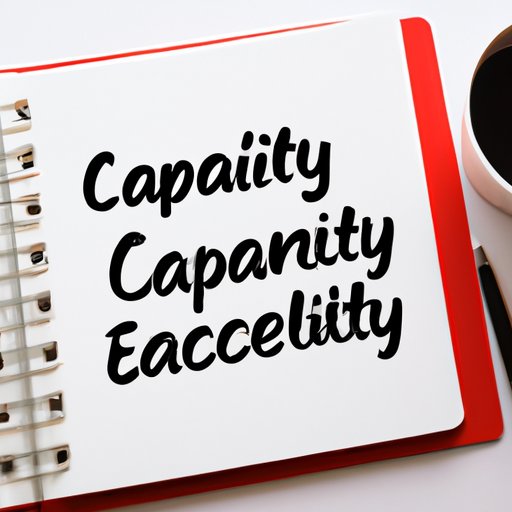
Capacity Planning: A Key Business Strategy
Capacity planning is a crucial aspect of any business. It refers to the process of assessing and managing a company’s ability to produce goods or services in response to market demand. An effective capacity planning strategy ensures that businesses operate efficiently, meet production targets, and achieve their financial goals.
In this article, we will explore the importance of capacity planning for business success, key elements of capacity planning, and how to create an effective capacity planning strategy. Additionally, we will discuss the role of technology in modern capacity planning techniques and best practices for capacity planning in diverse industries and sectors.

Why Capacity Planning is Important for Business Success
Forecasting demand is essential for businesses to meet customer expectations and maintain a competitive edge. Capacity planning plays a vital role in this process, as it enables companies to prepare for future demand and optimize their production process accordingly. Failure to plan can lead to unexpected demand surges, which can result in product shortages, production delays, and ultimately, dissatisfied customers.
Capacity constraints can have significant impacts on business operations. Overcapacity can lead to idle resources, missed cost savings opportunities, and decreased profitability. Meanwhile, under capacity can result in production bottlenecks, excess inventory, and inability to meet customer demands. Therefore, effective capacity planning is essential to avoid these negative outcomes and enable a company to meet customer demand in a timely and cost-effective manner.
Capacity planning is necessary for competitive advantage. By understanding their current capabilities and planning for future needs, businesses can effectively compete in their respective markets. In addition, efficient capacity planning enables companies to take advantage of market opportunities, offer more innovative products or services, and respond to changing customer needs.
Creating an Effective Capacity Planning Strategy
An effective capacity planning strategy involves several steps:
Identifying Key Capacity Planning Objectives
Companies need to identify key objectives for their capacity planning strategy. These objectives should align with their overall business objectives, long-term growth plans, and marketing strategies. Some companies may prioritize enhancing efficiency and reducing costs, while others may prioritize accommodating for future growth or enhancing product quality.
Assessing Performance Measures
Companies need to assess performance measures such as production output, production cycle time, inventory levels, and delivery times. These measures are essential for identifying areas where capacity planning improvements can be made.
Identifying Resources Required
Companies need to identify the resources required for effective capacity planning. These resources may include human resources, financial resources, and technological resources. Additionally, companies must ensure that their processes are optimized, and their employees are knowledgeable and skilled.
Developing a Capacity Model
A capacity model is a standardized approach for analyzing and forecasting capacity requirements. Typically, a capacity model includes data input, data processing, and output analysis. Companies can use the model to determine the capacity needed to meet current and future demand and optimize their production process accordingly.
Understanding the Key Elements of Capacity Planning and How to Apply Them
Capacity utilization rate refers to the ratio of actual production output to maximum production capacity. This rate determines whether a company is over or under capacity. If the rate is below 100%, then the company has underutilized its production capacity. Meanwhile, if the rate is above 100%, then the company has exceeded its production capacity.
Capacity planning techniques and strategies include level capacity strategy, chase demand strategy, and mixed lot strategy. The level capacity strategy involves maintaining a constant production rate, regardless of market demand. The chase demand strategy involves adjusting production based on fluctuating market demand. Finally, the mixed lot strategy is a mix of level capacity and chase demand strategy.
The capacity planning equation is straightforward. It involves calculating the difference between the anticipated production volume and the current production volume. This difference is then used to determine how much production capacity is needed to meet market demand.
The Role of Technology in Modern Capacity Planning Techniques
Advances in technology have significantly improved capacity planning techniques. Capacity planning software and tools automate the forecasting process, enabling businesses to analyze data more accurately and efficiently. This technology facilitates decision-making, planning, and forecasting.
Data analytics and machine learning are changing capacity planning in transformative ways. By analyzing vast amounts of data, businesses can gain insights into market trends and adjust their production process accordingly. This technology enables businesses to have more accurate demand forecasting and achieve higher capacity utilization rates, leading to increased efficiency and profitability.
Best Practices for Capacity Planning in Diverse Industries and Sectors
Capacity planning in service industries: In service industries such as hospitality, healthcare, and retail, understanding customer demand and optimizing service delivery is critical. Therefore, businesses must develop capacity planning strategies that prioritize staffing, training, and scheduling.
Understanding capacity in manufacturing and production industries: In manufacturing and production industries, production output and equipment capacity drive capacity planning. Companies should create a balanced production schedule that takes into account factors such as the cost of production and availability of resources.
Capacity planning in healthcare, education, and government sectors: In these sectors, the emphasis is on ensuring that resources are available to meet the needs of the population. Therefore, capacity planning strategies must focus on long-term growth and investment in infrastructure and technology.
Capacity planning in technology companies: In the technology industry, growth and innovation are key drivers. Therefore, capacity planning strategies must focus on developing flexible and scalable processes, expanding operational capacities, and investing in new technology.
Conclusion
Capacity planning is a crucial strategy for businesses of all sizes. By forecasting demand, understanding resources, and optimizing production processes, companies can achieve higher asset utilization, lower costs, and greater efficiency. Moreover, with modern technological advancements, businesses can better forecast demand and identify market trends, leading to increased growth and profitability. Remember, understanding your business operations and planning strategically is the key to success in today’s highly competitive business environment.
Tips for implementing a successful capacity planning strategy:
- Identify key capacity planning objectives and align them with your business’s objectives, long-term growth plans, and marketing strategies.
- Assess performance measures such as production output, production cycle time, inventory levels, and delivery times to identify areas for improvement.
- Identify the resources required for effective capacity planning, including human resources, financial resources, and technological resources.
- Develop a standardized approach to analyze and forecast capacity requirements.
Final thoughts on the future of capacity planning in organizations:
As technology continues to advance, capacity planning will continue to evolve, becoming more automated and data-driven. Companies that embrace these new technologies and techniques will be better positioned to compete in their respective markets, achieve operational excellence, and achieve their financial goals.




